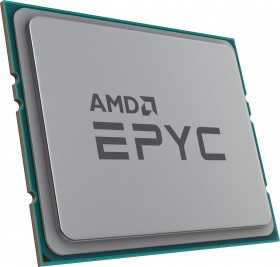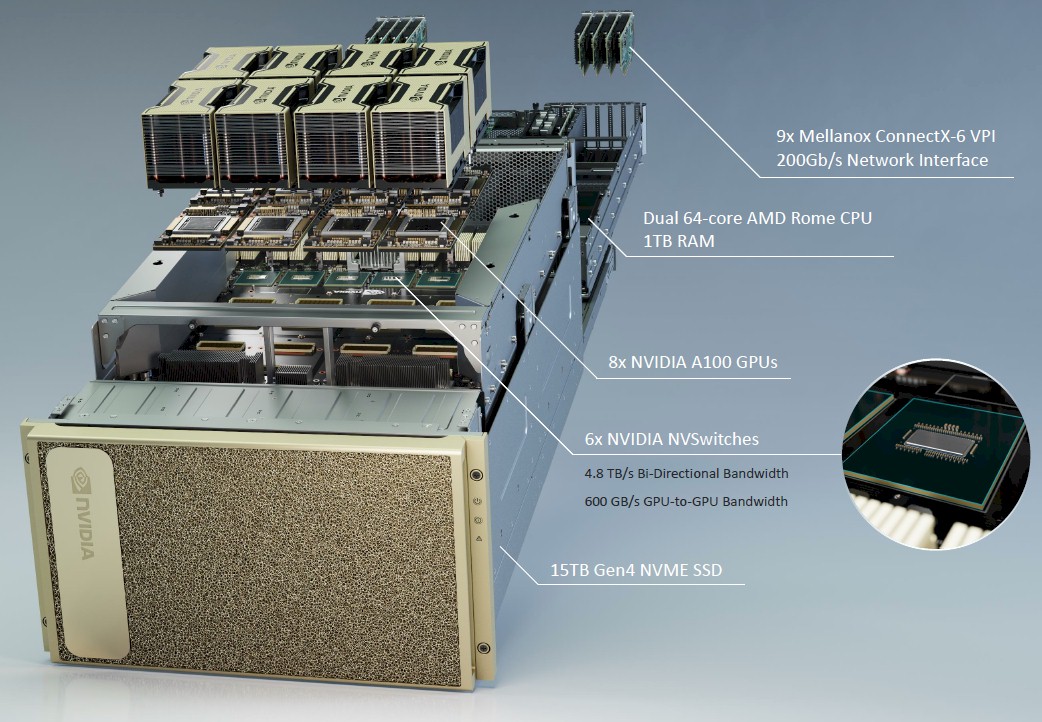 Today AMD demonstrated continued momentum in HPC with NVIDIA’s announcement that 2nd Generation AMD EPYC 7742 processors will power their new DGX A100 dedicated AI and Machine Learning system. AMD has an impressive set of HPC wins in the past year, and has been chosen by the DOE to power two pending exascale-class supercomputers, Frontier and El Capitan.
Today AMD demonstrated continued momentum in HPC with NVIDIA’s announcement that 2nd Generation AMD EPYC 7742 processors will power their new DGX A100 dedicated AI and Machine Learning system. AMD has an impressive set of HPC wins in the past year, and has been chosen by the DOE to power two pending exascale-class supercomputers, Frontier and El Capitan.
Each DGX A100 will feature dual 2nd Gen AMD EPYC 7742 processors, for a total of 128 cores, running at 2.25 GHz (base), 3.4 GHz (max boost). 2nd Gen AMD EPYC processors are the first and only current x86-architecture server processor supporting PCIe 4.0, providing up to 128 lanes of I/O, per processor for high performance computing and connections to other devices like GPUs.
In addition to the DGX-A100 systems, AMD EPYC processors are powering the following supercomputers around the world:
- HLRS ‘HAWK’: The High-Performance Computing Center Stuttgart (HLRS) selected DDN’s EXAScaler with IME scale-out flash storage system for “Hawk,” its new flagship supercomputer system. Hawk will empower scientists and engineers to conduct research on larger and more complex phenomena while supporting data-intensive workflows that combine big data analysis, deep learning and simulation. Hawk is an HPE Apollo 9000 System and is among the fastest supercomputers worldwide and the fastest general purpose system for scientific and industrial computing in Europe. It is also supported by 2nd Gen AMD EPYC processors.
- BIG RED 200: Indiana University acquired the fastest university-owned supercomputer in the nation to support its advanced research in artificial intelligence, machine learning, data analytics, and scientific and medical research, Big Red 200. The system replaced the highly successful Big Red II Cray supercomputer with speeds in excess of six quadrillion calculations per second. Big Red 200 is supported by 2nd Gen AMD EPYC processors and next-generation NVIDIA Tensor Core GPUs.
- NEC SX-AURORA TSUBASA at DWD: NEC was selected by the German weather forecasting service, Deutscher Wetterdienst (DWD), to build the system valued at 50 million Euro. Based on 2nd Gen AMD EPYC processors, the vector supercomputer is expected to be six times faster than DWD’s current supercomputer, and more powerful than those used by the British and French weather authorities. NEC SX-Aurora TSUBASA will support DWD with the monitoring, analysis and prediction of meteorological and climatological processes and drive sophisticated forecasts and warnings in case of severe weather events.
- ETH ZURICH EULER VI: ETH Zurich is using 2nd Gen AMD EPYC 7742 processors in its Euler VI system.
- DELL EXPANSE: The San Diego Supercomputer Center (SDSC) selected Dell Technologies to power its next-generation supercomputer, Expanse. Expected to deploy in mid-2020, Expanse will be powered by Dell EMC PowerEdge servers with 2nd Gen AMD EPYC processors and is expected to deliver peak performance of five petaflops. The system will enable tens of thousands of researchers to speed time to discovery in fields of astronomy, molecular dynamics, machine learning and artificial intelligence.
- CRAY ARCHER2: Cray and Hewlett Packard Enterprise (HPE) were awarded 48 million Euros to expand UK Research and Innovation’s (UKRI) high-performance computing capabilities with Cray’s next-generation Shasta supercomputer. The ARCHER2 supercomputer will be equipped with Slingshot interconnect, Cray ClusterStor high-performance storage, the Cray Shasta Software platform, and 2nd Gen AMD EPYC processors, giving it 11x higher performance than its predecessor, ARCHER. ARCHER2 will be the first Shasta system announced in EMEA and the second system worldwide used for academic research.
- CRAY VULCAN at AWE: United Kingdom’s Atomic Weapons Establishment (AWE) selected Cray and Hewlett Packard Enterprise (HPE) to support security and defense of the U.K. with the Cray Shasta supercomputer. The Vulcan supercomputer will feature a single Shasta supercomputer with expected performance of more than seven petaflops. The architecture will include the Cray Slingshot interconnect, 2nd Gen AMD EPYC processors and Cray ClusterStor Lustre storage. The high performance storage system will offer nearly 100 gigabytes per second of I/O performance.
- JOLIOT-CURIE: GENCI and Atos announced the first operational supercomputer worldwide to include 2nd Gen AMD EPYC 7H12 series processors. The Joliot-Curie supercomputer is based on Atos’ BullSequana XH2000 solution and has a sustained revised performance, thus far, of more than five petaflops. It also ranked No.59 on the TOP100 global ranking in 2019.
- ATOS BULLSEQUANA XH2000 Supercomputers: Atos was selected to supply French national meteorological service, Météo-France with two BullSequana XH2000 supercomputers based on 2nd Gen AMD EPYC processors. The new systems will multiply Météo-France’s computing power by more than 5x, compared to its current solution, enabling it to achieve several scientific breakthroughs in weather forecasting. Each new supercomputer is capable of processing more than 10 million billion operations per second and are amongst the most powerful meteorological supercomputers in the world.
- CRAY HPC11: The Air Force Life Cycle Management Center, in partnership with Oak Ridge National Laboratory, tapped Cray to supply a Cray Shasta supercomputing system with a contract valued at $25 million. The HPC11 supercomputer will enable higher fidelity weather forecasts for U.S. Air Force and Army operations worldwide. It will be one of the first supercomputing systems with 2nd Gen AMD EPYC processors for use in operational weather forecasting.




